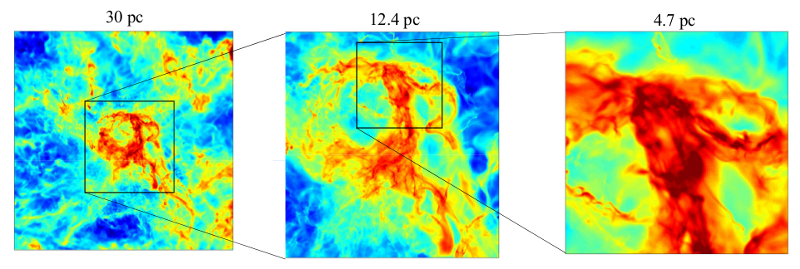| EPoS Contribution |
|
The Formation of Massive Clusters From High Redshift to the Present Day Universe
Richard Klein UC Berkeley/LLNL, Berkeley, US | |
| Massive stars lie at the center of the web of physical processes that has shaped the universe as we know it, governing the evolution of the interstellar medium of galaxies, producing a majority of the heavy elements, and thereby determining the evolution of galaxies. A significant fraction of all stars form in massive clusters, which will be observable throughout the visible universe with JWST. In this talk, I shall present first results of the formation of clusters of stars across cosmic time, both of moderate mass, such as the Orion Nebula Cluster (ONC), and of high mass, such as the super star clusters (SSC) seen in starburst galaxies, starting with high mass cluster formation in our present day universe. These simulations are carried out using newly developed advanced techniques in our radiation-magneto-hydrodynamic AMR code ORION, for radiative transfer with both ionizing and non-ionizing radiation that accurately handles both the direct radiation from stars and the diffuse infrared radiation field that builds up when direct radiation is reprocessed by dust grains. Our simulations include relevant feedback effects such as radiative heating, radiation pressure, photodissociation and photoionization, protostellar outflows, magnetic fields and turbulence. The challenge in simulating the formation of massive stars and massive clusters is to include all these feedback effects self-consistently as they occur collectively. I will first present our recent results on cluster formation on moderate scales over the dynamic range of ~ 5 pc down to 28 au for a period of 3.5 x 105 yr, including magnetic fields, turbulence and both radiative and outflow feedback from the protostars. At the end of the simulation, the star formation efficiency in the cluster is 4.3 % and the star formation rate per free-fall time is εff = 0.04, within the range of observed values. The total stellar mass increases as ~ t2, whereas the number of protostars in the cluster increases as ~ t1.5. We find that the density profile around most of the simulated protostars is ~ ρ ∝ r-1.5. At the end of the simulation, the protostellar mass function approaches the Chabrier stellar initial mass function. We infer that the time to form a star of median mass 0.2 Msun in the cluster is about 1.4 x 105 yr from the median mass accretion rate. We find excellent agreement in our simulations with the protostellar luminosities observed in recent large cluster samples and a theoretical estimate, and we conclude that the classical protostellar luminosity problem is resolved. The multiplicity of the stellar systems in the cluster simulation agrees, to within a factor of 2, with observations of Class I young stellar objects; most of the simulated multiple systems are unbound. Bipolar protostellar outflows are launched using a subgrid model, and extend up to 1 pc from their host star. The mass-velocity relation of the simulated cluster outflows is consistent with both observation and theory. I shall then present our first results on massive cluster formation starting at scales ~ 100 pc. and forming massive SSC clusters of ~ 106 Msun using multiple zoom-in refinements with AMR and including all of the above mentioned coupled physics. I shall discuss how we chose self-consistent initial conditions for massive cluster formation simulations, and show preliminary results of the properties of the massive SSC clusters and ONC type clusters that form. Key questions we are addressing include how effectively is radiation trapped within the cluster and how does stellar feedback affect the formation of Orion-scale clusters and SSC. | |
 | |
| Caption: The Figure shows column density maps from the initial conditions generation simulation of the formation of a superstar cluster showing massive gas concentration within a 12 pc region (middle panel) embedded in a 40 pc. highly turbulent magnetized cloud, where very dense gas clouds of ~ 106 Msun in a 4.7 pc region are formed (right panel) after evolving 3.1 cloud crossing times. Full physics including feedback effects due to radiative heating, radiation pressure, photodissociation and photoionization, and protostellar outflows are turned on with successive zoom-ins into the massive gas region after 4 crossing times allowing turbulence to cascade well below the sonic length scale. Superstar clusters will form inside of these massive dense gas clouds. The dimensionless parameters of the simulation are Mach 30 over an initially 40 pc magnetized turbulence cloud. The Alfven Mach number is 2. The compressive/solenoidal ratio of the turbulence driving at the outer scales is 2. The final resolution is 503 au and the initial B field strength of the entire region is 3.1×10-3 G. | |
| Collaborators: PS, Li, UC Berkeley, USA C.F. McKee, UC Berkeley, USA |
Key publication
Suggested Session: High-mass star/star cluster formation |

